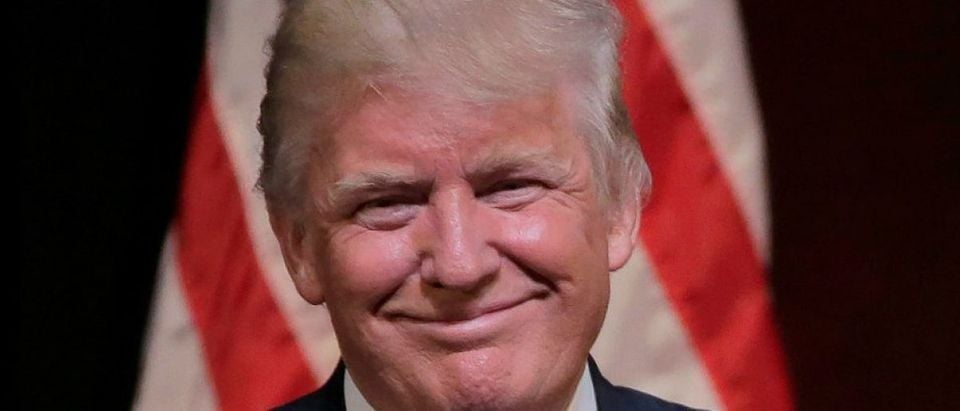An internal memo from Donald Trump’s presidential campaign obtained by FiveThirtyEight shows that Trump sought to court voters who felt a “persistent state of disenfranchisement” from the U.S. political process by offering them a “safe space” to express their views.
Trump’s campaign strategy during the 2016 primary season specifically targeted voters who “have been called ‘stupid,’ ‘racists,’ and ‘bigots'” by “elites,” according to the memo.
You can view the Trump memo in its entirety here. It’s dated January 14, 2016 — 18 days before the first-in-the-nation Iowa Caucus (which was Feb. 1).
The four-page memo by former Trump campaign staffer Matt Braynard is entitled “All In On ‘Low-P High-T.'”
In a nutshell, the unorthodox “Low-P High-T” strategy involved appealing to voters who had seldom — if ever — participated in a Republican primary or caucus. The pool of “Low-P High-T” voters, Braynard explained, included people who had a very low propensity to vote (“Low-P”) but who very enthusiastically support Trump (“High T”).
“These are people who may not know where to vote, whether or not they are eligible to participate, and what the hours are,” the Trump campaign staffer wrote.
“Many of them may have simply never been asked for their vote.”
“In the media and in certain social circles, our low-P supporters have been called ‘stupid,’ ‘racists,’ and ‘bigots.’ The ‘elites’ look down on them, and there is evidence they deny their support for our candidate for fear of being ostracized,” Braynard continued.
“Engagement scripts” targeting these voters “must all open with a warm and friendly disclosure: ‘I’m a volunteer for Mr. Trump’s campaign for President.’ This lets them know they’re in a ‘safe space.'” (Emphasis added.)
“Then we follow with an encouraging invitation: ‘We’d like you join us [sic], to help us Make America Great Again,'” Braynard advised. “Can we count on your vote in the upcoming primary?”
“Based on an internal analysis of our own modeling data and third-party research, and considering the exceptionalism of our candidate, I advise that we put one-hundred percent of our organizational effort into enfranchising the conventionally low propensity voters that support our candidate,” Braynard wrote.
The strategy — which appears to have been highly successful — was to let the other 15 Republican candidates fight over the pool of voters who could ordinarily be expected to vote in GOP primaries and caucuses. Trump would have frustrated, unlikely voters virtually all to himself — provided he could convince them to show up at the polls.
Line of people waiting to vote in #NHPrimary estimated to be 2 miles long in Merrimack https://t.co/3ktMY2ZER2 #WCVB pic.twitter.com/jcHDKgf2ue
— Steven (@StevenWCVB) February 9, 2016
The memo explained that the other major prong of the Trump campaign during the primary and caucus season was to rely on the massive amount of free media Trump was receiving compared to the media time given to all the other candidates.
Braynard told FiveThirtyEight that the strategy to focus on Trump-loving voters who wouldn’t normally bother to vote was in place through the Wisconsin primary, and perhaps beyond that time. (The Wisconsin primary, on April 5, was the 34th Republican primary.)
“Pat Buchanan, I think, accurately described these people as conservatives of the heart. These are law and order people who are rich in the wisdom of the Old Testament,” the Trump staffer said. (RELATED: From Immigration To Guns To Abortion, Donald Trump Must Reckon With His Progressive History)
Braynard, who said he was working virtually around the clock in an office inside Trump Tower, left the Trump campaign around the time of the Wisconsin primary.
He would not disclose the reason for his departure, but said he still supports Trump.
Stuart Jolly, a former national field director for the Trump campaign who now advises the Trump-supporting Great America PAC, lauded the strategy of targeting voters who love Trump but feel a “persistent state of disenfranchisement.”
“They had been left behind educationally and job-wise and hadn’t voted in a while,” Jolly told FiveThirtyEight. “It wasn’t rocket science: We were going after people who really hadn’t voted. They came out in droves; I didn’t realize there were that many.”
Braynard’s January 14 memo was addressed to four other staffers with two additional staffers copied. Corey Lewandowski was one of the two copied recipients.
Trump’s current campaign staff refused to discuss the memo, according to FiveThirtyEight.
Lewandowski also refused to comment.
Follow Eric on Twitter. Like Eric on Facebook. Send story tips to erico@dailycaller.com.


